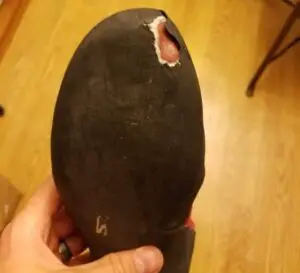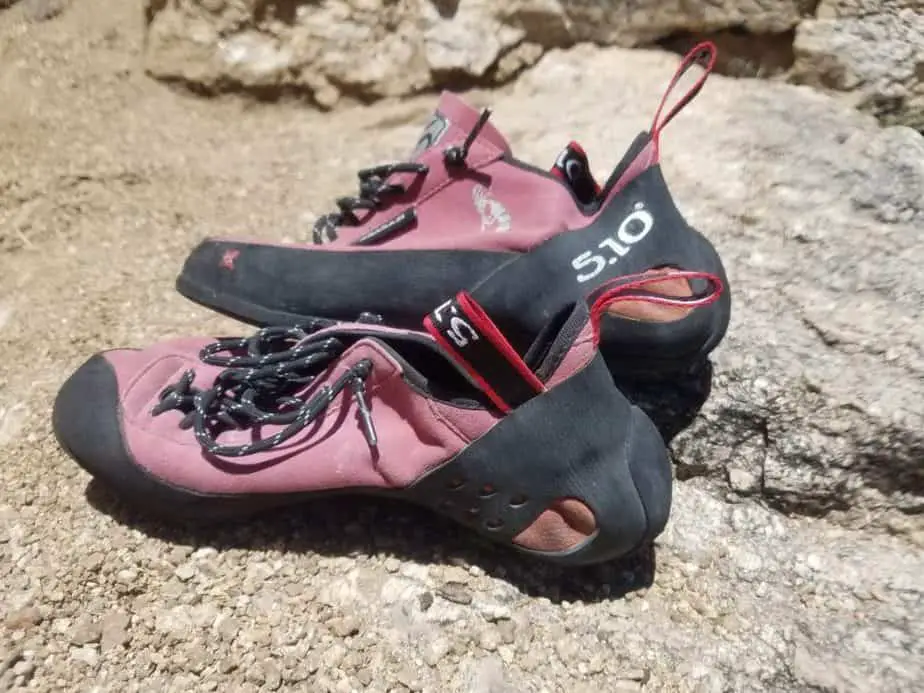Climbing shoes take the brunt of abrasive abuse on the wall, whether rock climbing or bouldering. While prices for new climbing shoes have come down over the years, especially as new players have entered the market, you’re still likely to burn through more than one pair per year if you climb consistently.
Making climbing shoes last longer starts with good footwork, as well as keeping your shoes clean. Keep them out of the sun, and make sure they maintain their structural integrity by wearing them correctly and ensuring the correct fit. Consider resoling them before it’s too late- otherwise you will have to buy new shoes.
It’s really important to take care of your climbing or bouldering shoes to help them last longer. Read on for some instructions and tips about how to best care for them.

Caring for Climbing Shoes
In taking care of climbing shoes, the old adage ‘an ounce of prevention is worth a pound of cure’ rings true. Once you’ve worn them too far, or let them get too disgusting, it can be impossible to fix them. Fortunately, you can take good care of your shoes and extend their life with these tips:
Practice Good Footwork:
A lot of climbers develop the habit of dragging their toes along the cliff or indoor wall as they feel for the next hold. While this can be necessary at times, it will definitely wear out the toe box of your shoes faster.
In general, the bottom of the shoes, especially around the toe and heel, are comprised of the thickest rubber. Try to use these areas instead of thinner areas like the rand, and be aware of what especially abrasive rock can do to your shoes.
Keep Your Shoes Clean:
When transitioning between the gym and the crag, it can be helpful to wash off the soles of your shoes. Climbing outside they can pick up sand and even very small rocks which will grind away the soles faster. You can wash them with water and a towel, and some mild detergent if necessary.
Along with this advice, is to keep your feet clean. If you step into your shoes with sandy or dirty feet, it’s some additional abrasion from the inside out- not to mention the added smell. For more information on how to clean your shoes, read this post .
.

Only Wear Them While Climbing:
Your shoes probably aren’t comfortable enough that I have to say this, but don’t wear them for the hike in to the crag. If you’re going to take a belay break or do much walking around, switch over to your approach shoes or sandals instead.
or sandals instead.
The more you wear them, the faster they’ll wear out. As mentioned above, the most abused areas of the shoes are reinforced, but some of the places that wear from regular walking aren’t.
Keep Climbing Shoes Out of the Sun:
Like with all climbing gear, the sun is not your friend. Obviously some exposure is just fine; but don’t ever just leave them sitting in the sun for a few hours, and never store them in the sun long-term.
Leaving rubber exposed to UV radiation for long periods of time makes (blah blah blah science answer) the materials deteriorate and ruins the elasticity. The rubber will become brittle, sort of like regular plastic. Make sure to keep them out of direct sunlight if you leave them in your car (in a bag or in the trunk).
Proper Storage:
Just because I said to leave them out of the sun doesn’t mean they should sit in a stuffy bag at the bottom of your closet all the time. There’s a reason your gym bag smells like it does. Mold and fungus are serious threats to climbing shoes.
Not only is it completely disgusting, but some types of mold will also break down the shoes. Keep them out of the sun, but still let them breathe rather than leaving them in a tight, stuffy space. You’ll know it if you screw this up!
Wear Shoes Properly:
It can be really tedious to put your climbing shoes on and take them off in between each route or boulder problem. If you do take them off, take them off all the way. Resist the urge to just slide your toes in and crush the heels. The heel box is a critical part of the climbing shoes and you need the structure to remain intact.
Don’t walk around with untied laces either. Aside from the obvious tripping hazard, you’ll wear through the laces pretty quickly if you grind them into the rocky ground. Be wary of crack climbing, as it will wear the tops and rands of your shoes much more quickly than regular climbing.
Ensure You Have the Correct Fit:
Climbing shoes should be comfortable enough to wear without pain, but just tight enough that you don’t wear them for fun. The more advanced you get, your shoes usually get a bit tighter and less comfortable as the toe becomes more aggressive.
If they’re too big or too loose, the wear will not be on the right reinforced sections (and you won’t have much purchase on small holds). I recommend trying shoes on before you buy them, or at the least reading a lot of reviews first to make sure they’ll fit you how you want them to.
Resole Your Climbing Shoes Before it’s Too Late:
There’s a sweet spot when resoling your shoes- too soon and you are wasting perfectly good rubber (and money), or too late and your shoes may not be salvageable.
It’s important to catch them right before they wear through to the rand, and especially before they cause any damage to the interior or upper leather/synthetic sections. Read on for more information about resoling climbing shoes.
If your shoes are past the point of no return, you should probably read my post: How Much Are Rock Climbing Shoes?
How to Tell if you Need to Resole
It’s good practice to get in the habit of taking a look at your shoes after each time you climb, especially outdoors where they’re more likely to wear quickly or get snagged on something.
Inspect the toe area, especially the edges. Keep an eye on any obvious chunks or worn areas, as they’ll probably wear through first. Sometimes you can take a chunk out of a shoe by kicking a particularly sharp rock. Notice any areas where the sole and rand touch and the wear impacts the rand.
Look all along the rand (upper rubber section) for any areas that might be taking some wear. The rand is much more difficult to replace, so as soon as you realize you are wearing on the rand, modify your footwork or get a resole done to add more rubber. Usually the wear happens when you go through the rubber on the bottom of the shoe into the rand.

As soon as you begin to wear on the rand at all, you need to think about a resole. The rand is more difficult, and more expensive, to replace than the sole. The rand isn’t designed to be climbed on, so the rubber is slightly harder and less grippy.
Another thing to check for, especially if you haven’t climbed in a while or if you pick up a pair of shoes used, is to feel the general state of the rubber. Rubber oxidizes over time, which means that it becomes less sticky and more hard. You can try to rough them up a bit with sandpaper (or sandstone), but it’s probably best just to resole.
Resoling Process for Climbing Shoes
Lots of different resoling shops have popped up around the world, especially in climbing-centric places. Most of the time they’re run by a climber or climbers, and it’s always good to support the local shops.
The first step is to determine if you need a half sole, whole sole, rand repair, or some patchwork done. This really depends how worn out they are and if you’ve started wearing in to the rand. The resoler should be able to help you make the decision if you’re not sure.
You need to decide between 4mm or 5mm rubber thickness (4mm is standard, but you may want 5 if you want them to take a beating). The cobbler takes the old sole off and glues a new one on, sanding down the edges for a perfect fit.
If you’re lucky, you can find someone close by to resole the shoes and you can save some money on shipping. A regular half sole costs around $40 at most places, so shipping can add to that. At a certain point, depending on the value of your shoes, it’s probably not worth it to you to salvage them. Shoe prices have come down in recent years, which makes it easy to pick up a new pair.

How Long do Climbing Shoes Last?
Of course, the answer is that it depends on how frequently you use them, whether you climb primarily indoors or outdoors, and how well you take care of them. For a beginning climber going once a week to a gym and occasionally outdoors, shoes can last a couple of years. If you’re going several times a week outdoors, expect to go through a couple of pairs per year.
You can only resole a shoe 2-3 times before it starts falling apart. Eventually, the rand will completely wear through, and the synthetic/leather upper will fall apart. Kiss them goodbye, and put them in a trophy case. Worn climbing shoes are PERFECT for Deep Water Soloing , so it’s good to have a good pair around!
, so it’s good to have a good pair around!
Related Questions
How much does it cost to resole climbing or bouldering shoes? For a half sole, it costs about $40 to resole. If you need rand repair, plan to spend an extra $10 to $20 depending on the severity. You can save a lot on shipping by sending multiple pairs at once.
Can I repair my own climbing shoes? There have been kits available online in the past, but it’s just a hard thing to do well by yourself. Consider apprenticing yourself to a cobbler if you really want to learn.
Can you put climbing shoes in the dryer? Do not put your climbing shoes in the dryer. The heat will have a similar effect on the shoes as the sun will- it can make them brittle and make them wear down faster. Let them air dry out of direct sunlight.
See Also:
Can I Rock Climb without Shoes?

